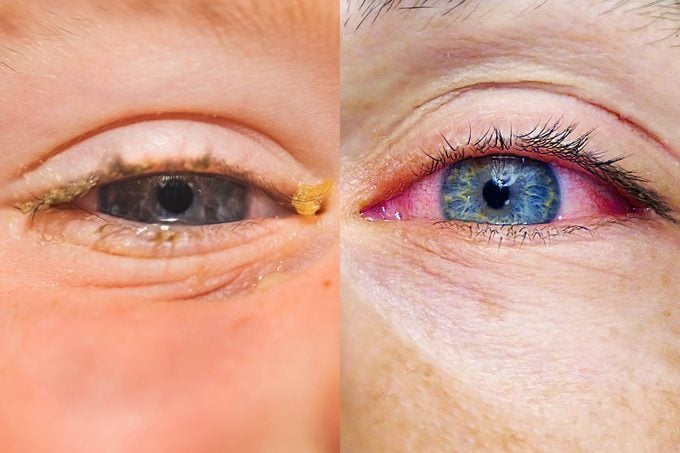Allergies or Pink Eye: Here’s How to Tell the Difference
Updated: Apr. 01, 2022
We give you the breakdown to help you soothe your red, itchy eyes the right way.

Red, itchy eyes are a tell-tale sign of either allergies or pink eye, which can be disconcerting when you’re trying to find the proper remedy to ease the irritation. But before you hit up the pharmacy or schedule a doctor visit, take a look at this guide to help you distinguish the difference between allergies or pink eye. (In the picture above, the left photo shows pink eye and the right one exhibits eye allergies.)
Pink eye is just a simpler term doctors use with their patients to describe conjunctiva inflammation—here are 13 other secrets eye doctors won’t tell you. Pink eye is otherwise known in the medical world as conjunctivitis. A thin layer, called the conjunctiva, lines the white part of the eye and inside of the eyelid to help keep our eyelids moist, according to the CDC. When the conjunctiva is irritated by allergens or infected by viruses or bacteria, pink eye can ensue. Reddening in the white of the eye, itching, burning, and increased tear production are just a few of the pink eye symptoms. But conjunctivitis can manifest itself in many ways depending on its cause.
Besides, a pink eye diagnosis doesn’t necessarily mean you’re contagious either. Only viral and bacterial infections can cause contagious cases of conjunctivitis. The most common type of pink eye is viral conjunctivitis, which is accompanied by a watery discharge and burning sensation in the eye, according to the American Academy of Ophthalmology. A respiratory infection or cold or flu virus is typically the culprit behind this kind of pink eye. Inflammation usually begins in one eye and potentially spreads to both eyes within days, especially if you use the same hand to rub both your infected eye and uninfected one.
“Someone who has pink eye will usually have a discharge that starts in one eye and spreads to two eyes,” says Wuqaas M. Munir, MD. Dr. Munir is an associate professor of ophthalmology and visual sciences at the University of Maryland School of Medicine. “It feels more irritated like something is in the eye versus an itchy eye for allergies.”
Other than the cause, the key difference between allergies or pink eye is also in the symptoms, particularly the discharge consistency. A thick pus-like discharge that makes your eyes stick together is usually a clear sign of bacterial conjunctivitis. Staphylococcus aureus, the bacteria that causes strep throat, is just one of the many types of bacteria that could infect your eye and lead to bacterial conjunctivitis. However, you may see little to no discharge in some cases of this type of pink eye.
Unlike the other two types of pink eye, allergic conjunctivitis isn’t contagious and is just your body’s response to allergens like pollen, pet dander, dust mites, and these other 11 surprising triggers of spring allergy symptoms. Your body releases histamine, a chemical that causes inflammation in the body, every time you are exposed to allergens. Thus, the vicious cycle of intense itching, tearing, and swelling in both of the eyes begins. “If we look under the eyelid we may find bumps indicative of allergies called papillae,” says Jules Winokur, MD, an ophthalmologist with Lenox Hill Hospital in New York City told health.com.
Aside from keeping notes of your symptoms, you should also refer to your medical history. If you have seasonal allergies or a recent history of pink eye, that could also help you narrow down the cause. Even asking yourself if you’ve been around anyone with pink eye lately can help.
Now you don’t need to run off to your doctor’s office at the first sign of red, itchy eyes. Most cases of pink eye are mild and will clear up on their own without treatment or a doctor’s visit. Viral conjunctivitis typically clears up within two weeks. But if you want to speed up the healing process, Dr. Munir says you can “try over-the-counter eye drops and if you’re not better in the first week or two then seek out an eye care professional.” If your own remedies aren’t working, your doctor will prescribe you with antibiotics for bacterial conjunctivitis, antiviral medication for viral conjunctivitis, or allergy medications for allergic conjunctivitis. You should also consider seeing your doctor if you experience pain or intense redness in the eyes, light sensitivity, blurred vision or your symptoms worsen with time. Now that you know the difference between allergies and pink eye, check out the other similarities and differences between allergy and cold symptoms.